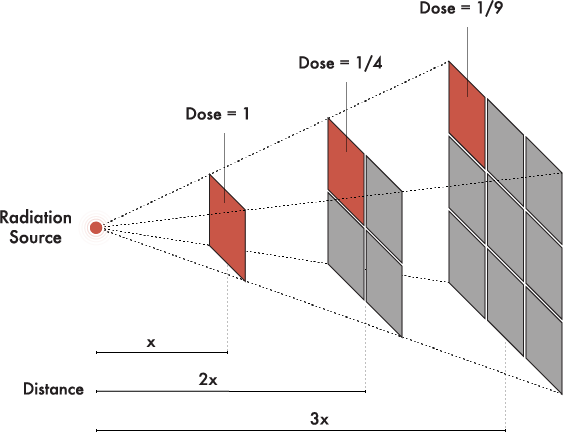There are several factors that are involved in protection against radi-ation exposure. They include: 1) the amount of time exposed, 2) the distance between the victim and the source of radiation, and 3) shield-ing materials.
The relationship between exposure time and the amount of damage is directly proportional. The longer one is exposed to the radiation, the more dosage of radiation one will receive. Therefore, minimizing the exposure time will greatly reduce the dosage of radiation the body receives. However, when radioactive materials are inside the body (either through swallowing or absorption), one has to wait until they decay or until one’s body eliminates the material. When that happens, the concept of half-life controls the time of exposure.
Increasing the distance between the victim and the source of radiation can also act as a protection. This relationship can be calculated with a little bit of math called the Inverse Square Law. The Inverse Square Law basically states that the intensity or strength of the radiation is inverse-ly proportional to the square of the distance from the source. Using the equation:where I is the intensity of the radiation, P is the total power of the radia-tion, A is the area (of a sphere) of radiation, and r is the radius of a circle or distance from the source.
For example, the exposure of an individual sitting 4 feet from a radia-tion source will be ¼ the exposure of an individual sitting 2 feet from the same source. To determine the ratio of exposure with the same intensity (I) and power of radiation (P), just divide the area (A) of one individual from the area of the second individual:
So, this means that when the distance increases by only 2 feet, the radi-ation is spread out over four times as much area, so the dose is only one fourth as much (Figure 13). Also, it is likely that the radiation will lose energy as distance increases thus reducing the intensity even further.

Another way to protect against radiation is using shields. Radiation shielding can be accomplished with various materials that will absorb radiation between a person and the source of the radiation. One type of very effective shielding material is called Graded-Z shielding. Graded-Z shielding is composed of a laminate of several materials with different Z values (Z values are used to indicate atomic numbers.) This type of material has been shown to reduce electron penetration over 60%. The most common Graded-Z material involves a gradient from high-Z (usually tantalum) through lower-Z elements such as tin, steel, and copper, usually ending with aluminum. Sometimes even lighter materials such as polypropylene or boron carbide are used.